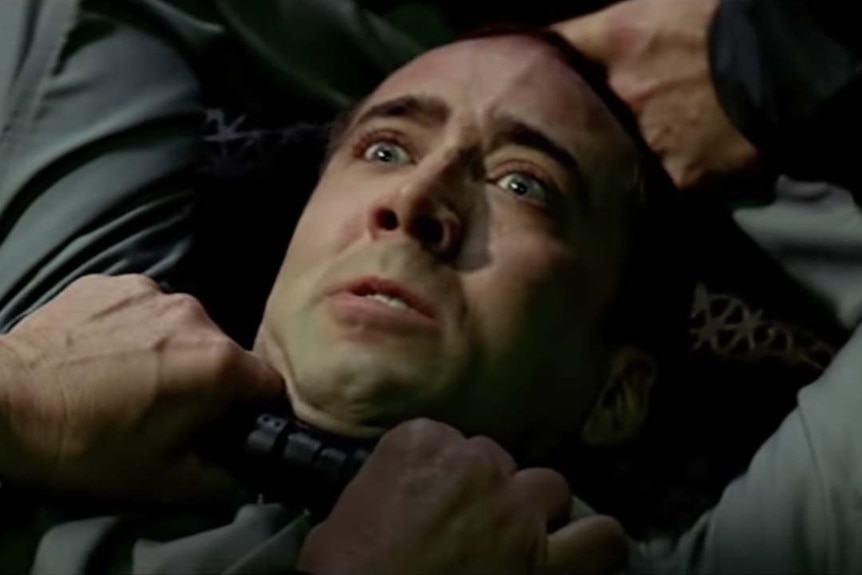Create a free profile to get unlimited access to exclusive videos, sweepstakes, and more!
How Face Transplants Work: The Science Behind Face/Off
You don't need to worry about Nicolas Cage stealing your identity anytime soon.

It’s almost shocking that Face/Off (the sci-fi thriller that's now streaming on Peacock, not Face Off, SYFY's special makeup effects competition show) ever got made at all. It’s hard to imagine how that pitch meeting must have gone, but it resulted in one of the wackiest and most fun thrillers of the late ‘90s. In it, Sean Archer and Castor Troy (both played alternatingly by John Travolta and Renfield's Nicolas Cage) trade faces before spiraling into a fight to the death.
When Face/Off came out in 1997, full face transplants were still an imagined future medical procedure. The first partial face transplant wouldn’t take place in the real world for another eight years, and the first full face transplant didn’t happen until 2010. When the movie came out, the idea of someone else being able to take your face was the ultimate in fictional stolen identities, but that’s not exactly how they work. Getting somebody's face off — and then on to another person — is a complicated medical marvel.
The Science Behind Face/Off's Face Transplants
While face transplants aren’t exactly routine, they’re certainly no longer wholly in the realm of fiction. As of 2021, 47 face transplants had been completed globally, two of which were retransplants. Those transplants were the result of research which began in 1991 when the Rehabilitation Research & Development Service of the United States Department of Veterans Affairs held the first conference to discuss composite tissue transplants — transplants involving multiple tissues including fat, skin, muscle, nerves, etc.
It is, perhaps, unsurprising that the military would have a special interest in these sorts of operations as military veterans are as likely a demographic as any to benefit from life-enhancing transplantations. By 1997, when the second conference on composite tissue allotransplantation (CTA) was held, the specifics of the operation itself had been worked out, but it was unclear if immunosuppressant therapies were up to the task of preventing rejection of skin, which is the most immunogenic of all organs.
Before the first facial transplantation could take place, other CTA operations were carried out, including hand and limb transplants. These were thought of as necessary first steps as they carry with them many of the same challenges.
Then, in November of 2005, all of that work came together. The recipient of the first partial face transplant was Isabelle Dinoire, a patient who had suffered dog bite injuries to the face while unconscious. The operation was a success, although Dinoire did go through episodes of rejection, kidney disease, and cancers, which may have been related to the immunosuppressant drugs.
Details about all of the facial transplants which have been conducted since Dinoire aren’t fully available, owing to the privacy of patients and differences in medical record availability around the world, but there have recently been some pretty stunning results.
Patrick Hardison is a firefighter who suffered extensive burns in 2001. He spent the next 14 years unable to close his eyes fully, and dependent on breathing and feeding tubes. Then, in 2015, he received a facial donation from David Rodebaugh, a 26-year-old who died in a bike accident. The operation, which took place at NYU Langone Medical Center, took 12 hours and included the transplantation of the scalp, ears, and face, including the eyelids and muscles to control them. A year later, doctors were able to remove Hardison’s breathing and feeding tubes.
In 2023, a team of surgeons at NYU Langone performed the world's first whole eye and partial face transplant. The patient, a 46-year-old man, was injured when his face came into contact with a live electrical wire. During a 21-hour operation, doctors transplanted the nose, left upper and lower eyelids, left eyebrow, upper and lower lips, and all of the underlying cheek, nasal, and chin bones, muscles, blood vessels, and nerves. They also transplanted the entire left eye and eye socket, including the orbital bones and the supporting muscles, along with the optic nerve.
Stem cells were also gathered from the donor and injected into the recipient's optic nerve connection point. The hope was they would facilitate nerve regeneration and connection, potentially restoring vision. Doctors did confirm that the eye was receiving good blood flow. A lot has changed since the first face transplant, less than 20 years ago.
How Face Transplants Work
The operation as portrayed in the movie is almost laughable. It takes place over only a couple of minutes. Surgeons use a laser to trace the outline of the face and then lift it away, as if there are no other connective tissues underneath. At one point they even cut and dye Archer’s hair while his face is removed. So much for a sterile operating theater.
In reality, the process is much more complex, and the results aren’t quite as seamless. According to John’s Hopkins Medicine, a facial transplant operation involves two surgical teams working in tandem. The first prepares the receiving patient for the new face while the second prepares the donor.
Rather than simply lifting the donor face away and placing it down on the recipient, there are a whole host of connections which need to be made in order for the new face to perform as desired. Plates and screws need to be locked down and surgeons must connect the donor face to the body’s veins, arteries, and nerves using a surgical microscope. Once they’ve confirmed that blood flow is connected, then they meticulously connect any additional nerves and muscles. Without that, the recipient wouldn’t get any of the function which is the primary medical use of a facial transplant.
Recovery times can take several weeks as the body acclimates to the new tissues. Transplant recipients will also likely experience significant swelling which will change the shape of the face over time. It’s also likely that additional operations will be needed once the swelling subsides to make minor adjustments so that the patient gets the most out of their transplant.
Importantly, even if everything goes off without a hitch, the recipient won’t look exactly like their donor. The soft tissues of the face are only one part of the equation. How those features sit on the skeletomuscular structure of the recipient are also key.
In order to pull off the sort of face swap we see in Face/Off, you’d need massive advances in surgical techniques, immunosuppressant technologies, and the ability to make fine adjustments to both donors and recipients such that the end result is a perfect match. While facial transplants are no longer a fiction and have provided significant improvements in quality of life for patients, the operation seen in the movie remains a fantasy.
That’s probably for the best. We can’t imagine a scenario, even a medical one, where you’d want the transplant recipient to look exactly like the donor.
Face/Off is now streaming on Peacock.
Originally published May 29, 2023.




























